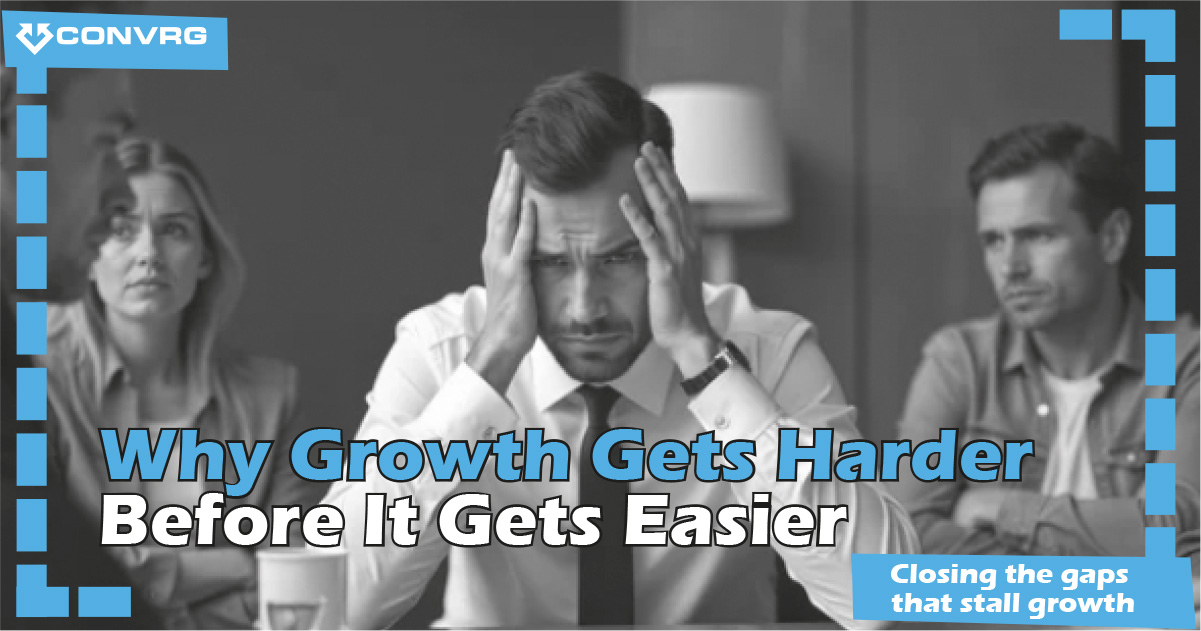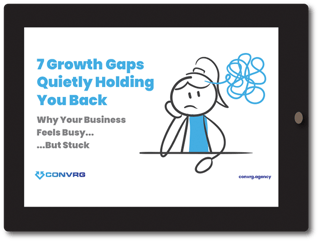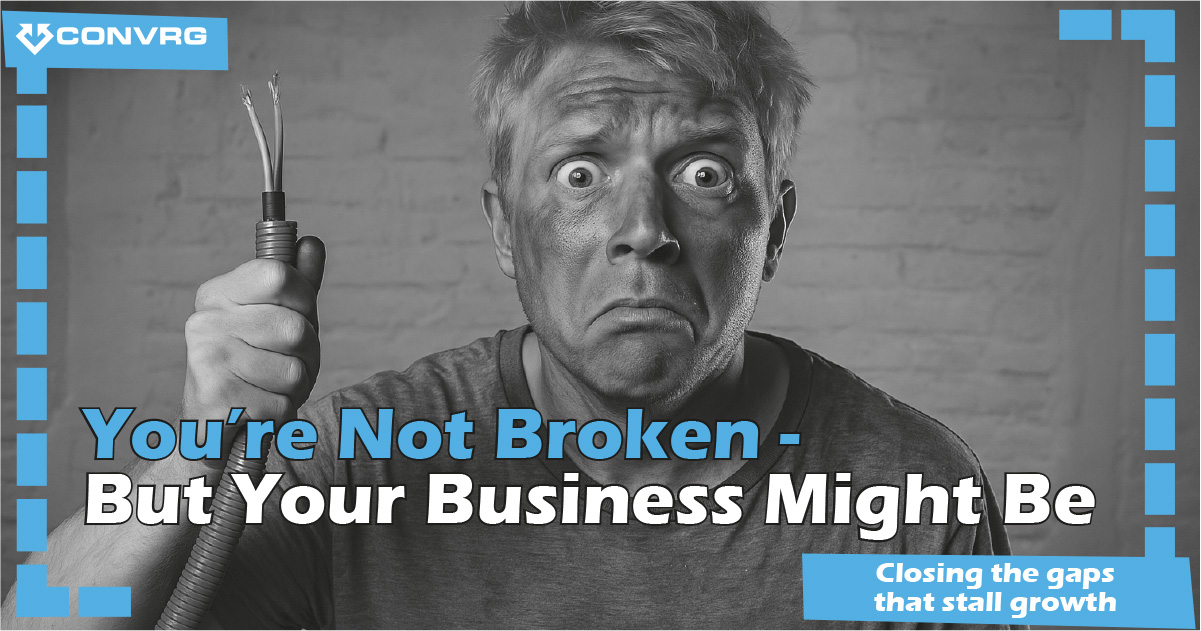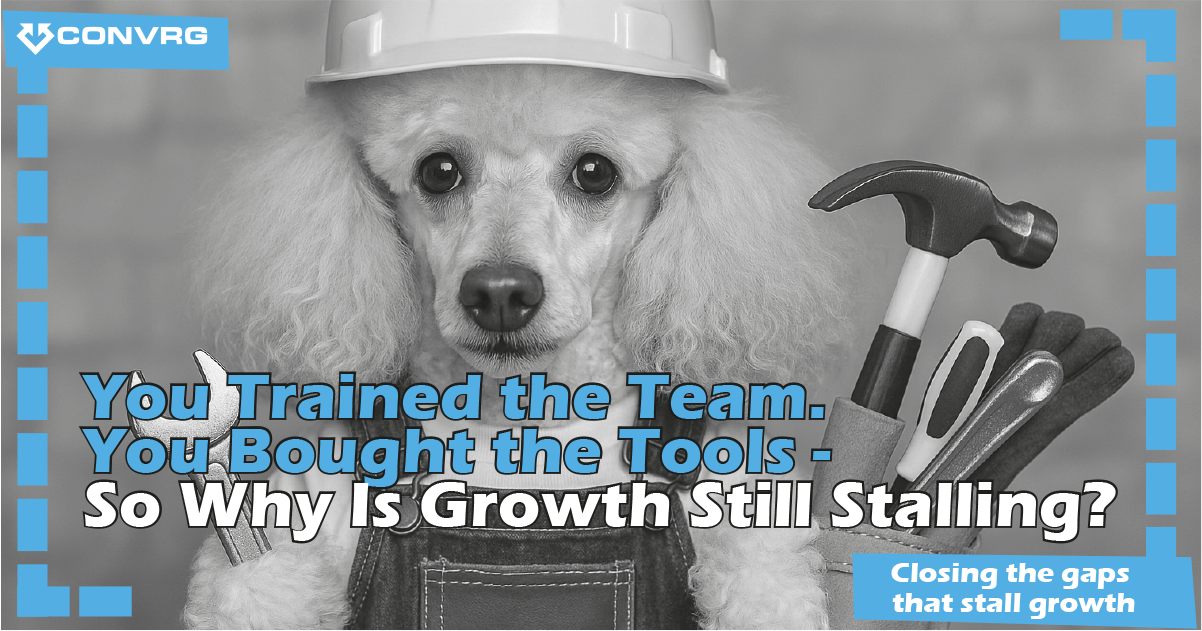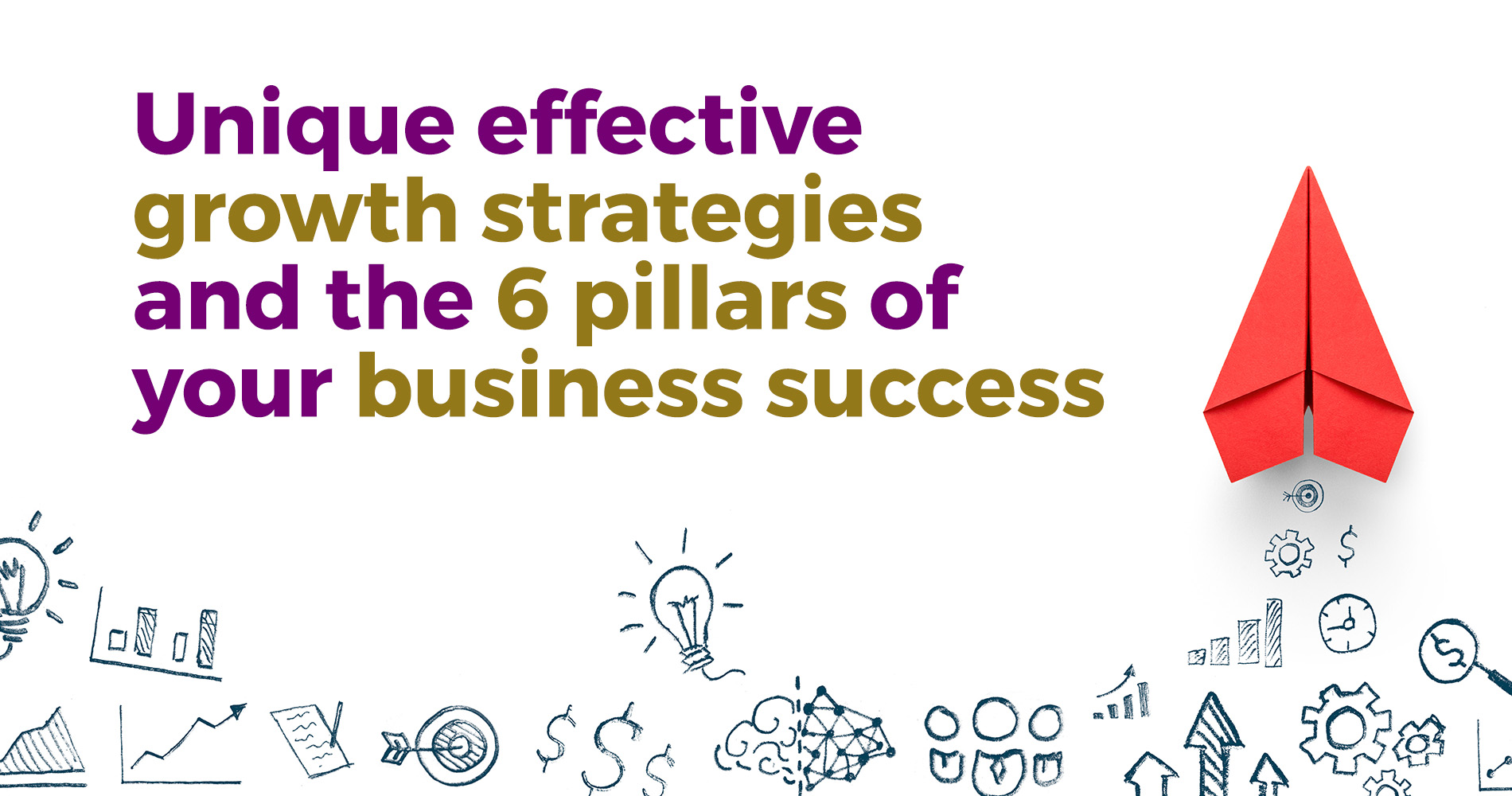You know your business is capable of more.
You’ve built a strong team. You’ve got the tools in place. You’ve made smart investments. But somewhere along the way, growth started to feel heavier.
Not broken. Not failing. Just... harder.
More meetings. More workarounds. More uncertainty. Progress that once felt fluid now feels like a grind.
And the worst part?
You can’t quite put your finger on what’s wrong.
If that sounds familiar, this article is for you. Because we’ve seen it dozens of times in B2B companies that are scaling fast - and feeling the drag.
At CONVRG, we call it the turning point: the stage where the old way of working no longer fits the business you’ve become.
Growth gets harder before it gets easier - not because you’re failing, but because you’ve outgrown how you used to grow.
Let’s explore what that really means - and what to do about it.
The Growth Paradox: More Success, More Friction
In theory, growth should make things easier. More revenue, bigger team, better tools.
But what we see inside scaling companies is the opposite:
- Alignment starts slipping
- Systems become more complex, not less
- Teams are busy, but goals are fuzzy
- Everyone’s doing their best - but still frustrated
You’re doing more of everything, yet getting less from it.
That’s the growth paradox. The same energy that once fuelled success starts creating friction. What used to work starts working against you.
You’re Not Broken - But Something Is
This is the first shift most leadership teams need to make.
You’re not broken. Your people aren’t lazy. Your strategy isn’t wrong.
You’ve simply reached the limits of your current operating model.
The way you’re set up - the tools, processes, and habits you’ve relied on - has carried you this far. But now, it’s quietly holding you back.
And unless you spot the real issues beneath the surface, your team will keep trying to sprint through mud.
What We’ve Learned from the Inside
We’ve worked with dozens of B2B firms - from industrial manufacturers to SaaS scale-ups to service providers - and the same patterns keep showing up.
Different tools. Different teams. Same friction.
In every case, we’ve found that growth drag comes from hidden structural issues - what we call Growth Gaps.
These aren’t buzzwords. They’re real, observable breakdowns in how teams, systems, and strategies connect.
Let’s walk through them.
The 7 Growth Gaps Quietly Holding You Back
These are the seven most common - and costly - gaps we see inside scaling businesses.
You might not have all of them. But chances are, you’ve felt a few.
- The Sales Gap
Leads aren’t converting. Sales teams are winging it. Forecasts are guesswork.
Sales has tools, but not trust. There’s no single version of the truth. Reps operate differently. Data is inconsistent. And the forecast? More hope than science.
What you’ll hear:
- “We just need more leads.”
- “Deals keep stalling at the same point.”
- “No idea if we’ll hit target this quarter.”
- The Marketing Gap
Activity is high, results are low. You’re not sure what’s landing or why.
Campaigns are happening, but conversion is unclear. Attribution is a mystery. There’s no feedback loop with sales. And spend is hard to justify.
What you’ll hear:
- “What happened to that campaign?”
- “We’ve got leads, but sales say they’re rubbish.”
- “Our content isn’t landing like it used to.”
- The Data Gap
Too many systems, too little clarity. You can’t trust your dashboards.
CRMs, spreadsheets, project tools, ERPs - all telling slightly different stories. Reports don’t match. Leaders don’t trust the data. Decisions are made on gut.
What you’ll hear:
- “Is this the latest report?”
- “Our numbers don’t line up.”
- “Let me check in Excel.”
- The Leadership Gap
Different visions, different goals, no shared picture of progress.
The leadership team is aligned in principle, but disconnected in practice. Goals don’t cascade. Departments operate in silos. Strategy becomes reactive.
What you’ll hear:
- “We’re not all pulling in the same direction.”
- “That’s not my team’s priority.”
- “We said yes to everything - and now we’re stuck.”
- The Customer Gap
Great products, but average experiences. The journey feels disjointed.
Customers fall between the cracks. Handovers are clunky. Data doesn’t follow the buyer. Support teams have no context. NPS scores drop. Loyalty suffers.
What you’ll hear:
- “Didn’t someone already deal with this?”
- “That’s not my department.”
- “We need a better onboarding process.”
- The Execution Gap
Everyone’s working hard, but not together. Energy gets lost in the noise.
Initiatives stall. Projects drift. There’s effort everywhere, but outcomes are inconsistent. Strategy exists - but delivery is scattered.
What you’ll hear:
- “We started strong, but then it fizzled out.”
- “There are too many priorities.”
- “No one really owns this.”
- The AI Gap
There’s pressure to adopt AI tools, but no strategy or integration.
Leadership wants to be innovative. Teams are experimenting. But nothing sticks. AI tools are bought but not embedded. It feels more like panic than progress.
What you’ll hear:
- “We need to do something with AI.”
- “Try this tool and see what it does.”
- “That pilot didn’t really go anywhere.”
Sound Familiar?
These gaps rarely show up alone.
In fact, most of the companies we support are grappling with 3–5 of these gaps at once. And that’s why growth feels harder than it should.
Because it’s not one big problem - it’s layers of small breakdowns, each dragging performance and draining energy.
The Warning Signs Are Already There
Even if you haven’t named them yet, you’ve probably felt the symptoms:
- Sales and marketing aren’t aligned
- Your CRM is underused or misused
- Data lives in silos and doesn’t tell the full story
- Teams rely on workarounds, not systems
- Leaders feel stuck - knowing something’s off, but not what
If that’s where you are, you’re not alone.
You’ve hit the point where growth needs structure, not speed.
Why the Usual Fixes Don’t Work
Here’s what we often see when teams try to fix this internally:
- They buy more tools
- They restructure teams
- They push harder on KPIs
- They launch new dashboards
But without fixing the underlying systems, these just add more complexity.
You can’t grow your way out of systemic friction. You have to design your way out.
What Actually Works: Aligning People, Process, and Platform
At CONVRG, we don’t believe in silver bullets.
We believe in alignment - real, functional, scalable alignment across:
- People – Everyone knows what they’re doing, why it matters, and how to get it done
- Process – Ways of working are intentional, not accidental
- Platform – Tools reflect how you work, not how the vendor says you should
That’s the work. Not a tech implementation. Not a rebrand. Just making the business work as one system.
We use our SIMPLIFI Framework to guide that process - helping teams close the gaps from the inside out.
What Happens When You Close the Gaps
When teams do the hard work to align, things change fast:
- Sales forecasts become trustworthy
- Campaigns drive revenue, not just clicks
- Customers stay longer and buy more
- Meetings get shorter
- Strategy turns into delivery
- Leaders stop second-guessing every report
It doesn’t happen overnight. But the change is real - and worth it.
How Frontier Medical Group Closed Their Gaps
One of our clients, Frontier Medical Group, was stuck:
- Legacy data and disconnected systems
- Sales, marketing, and ops all working hard - but separately
- CRM sitting unused, full of duplicates
We worked with them to apply our framework. Within months:
- Leadership had clear visibility
- Teams were finally aligned
- HubSpot became the engine for commercial execution
Growth didn’t just restart - it accelerated.
Where to Start: Download the 7 Growth Gaps Guide
If this article has made you nod, even once - it’s time to get specific.
The 7 Growth Gaps Guide gives you:
- Clear definitions of each gap
- First steps to start closing them
It’s not fluff. It’s a practical tool built from what we’ve seen on the inside.
[Download the 7 Growth Gaps Guide]
Because the sooner you name the gaps, the sooner you can fix them.
Final Thought: It’s Not About Tools. It’s About Traction.
Growth drag doesn’t mean you’re broken. It means you’re evolving.
But evolution needs design. It needs clarity. It needs alignment.
Closing the gap isn’t a project. It’s a path.
If you’re ready to walk it, we’re here to help.

